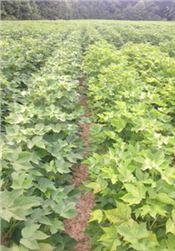Sulfur Deficiencies In Cotton
DR. TYSON RAPER AND DR. FRANK YIN
JACKSON, TENN.
Sulfur (S) deficiencies have been becoming more common in cotton fields in recent years. This is in part due to a reduction in sulfur emissions from manufacturing plants and diesel fuels. Nitrogen (N) and S deficiencies are commonly confused – particularly late in the season. Although both cause chlorosis of leaf tissue, the mobile nature of N within the plant results in deficiency symptoms first appearing low in the canopy. In contrast, S is very immobile in the plant and, as a result, S deficiency symptoms first appear in new growth near the top of the plant.
Several scientists across the cotton belt have been examining the impact of S on cotton yields. Dr. Frank Yin, Associate Professor in the Department of Plant Sciences for the University of Tennessee, is currently conducting field trials to examine the response of West Tennessee cotton to applied fertilizer S. The two images included here were taken from his trial earlier this year. As you can see in these pictures, severe deficiency symptoms were visible by first flower. This year marks the second year for the study and although yield response from this year is yet to be determined, results from a previous study (2008-2010) have indicated an application of 20-30 lb S can increase cotton yields by 8 to 9 percent in West Tennessee.
Another scientist examining the impact of S on cotton yields is Dr. Syam K. Dodla, Assistant Professor of Soil Fertility and Crop Irrigation at Louisiana State University. Dr. Dodla has recently completed a Plant Management Network presentation on this issue entitled, ‘Sulfur Fertilization of Cotton’. This presentation covers soil analysis for S deficiencies, outlines how to identify S deficiency symptoms in plants, covers the effects of S on cotton yields, and highlights potential sources of fertilizer S. For more information on the relationship of S and cotton (and methods to prevent the deficiency) watch Dr. Dodla’s presentation and keep an eye on UTcrops.com for the results from Dr. Yin’s trial. ∆
DR. TYSON RAPER: Cotton & Small Grains Specialist, University of Tennessee
FRANK YIN: Systems Agronomist, University of Tennessee

Figure 1: Sulfur deficiencies in the upper canopy of
blooming cotton during the 2015 season.
Photos courtesy Mr. Bob Sharp

A field trial at Ames Plantation near Grand Junction, Tenn. during the 2015 season.
The left two visible rows have received 20 lb S in the form of ammonium sulfate.
The two rows to the right have not received an S application and are showing
severe deficiency symptoms. A field trial at Ames Plantation near Grand
Junction, Tenn. during the 2015 season. The left two visible rows have received
20 lb S in the form of ammonium sulfate. The two rows to the right have not received
an S application and are showing severe deficiency symptoms.